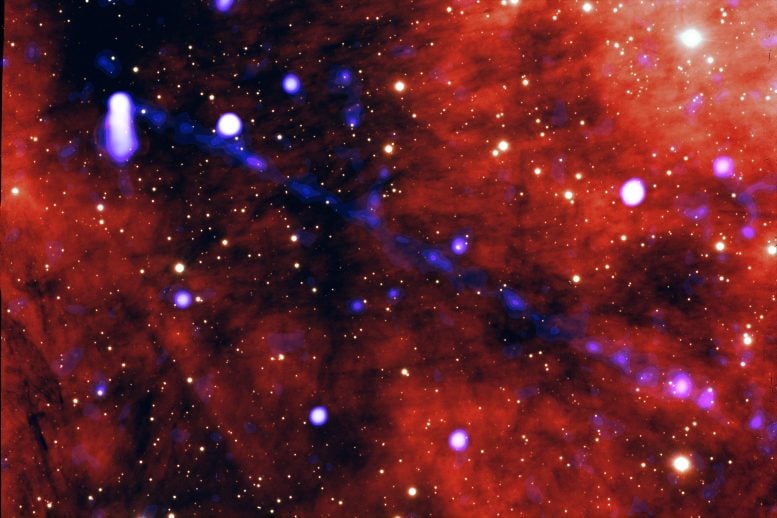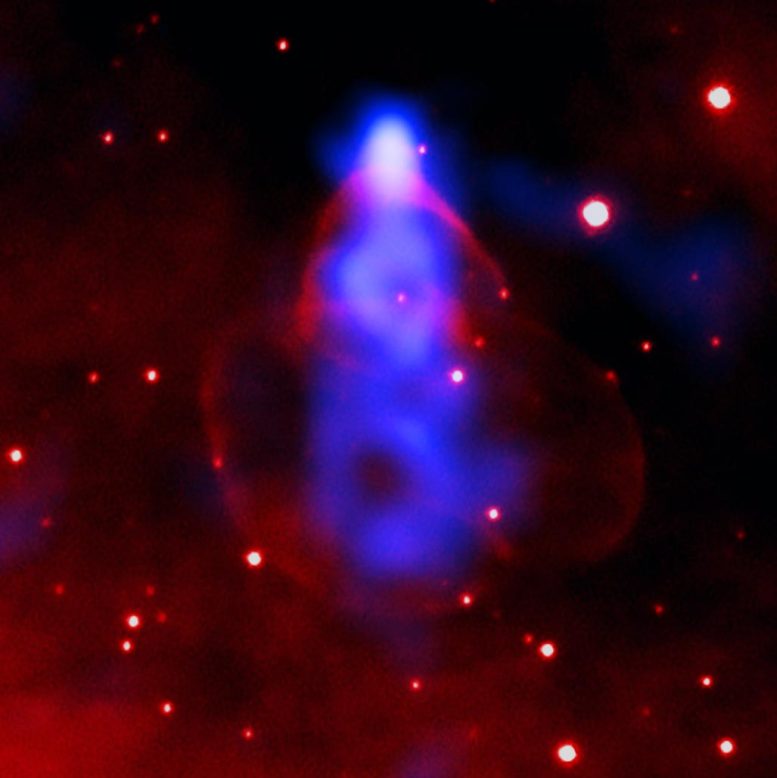
Astronomers have imaged a beam of matter and antimatter that is 40 trillion miles long with NASA’s Chandra X-ray Observatory. The record-breaking beam is powered by a pulsar, a rapidly rotating collapsed star with a strong magnetic field.
With its tremendous scale, this beam may help explain the surprisingly large numbers of positrons, the antimatter counterparts to electrons, throughout the Milky Way galaxy.
Astronomers first discovered the beam, or filament, in 2020, but they did not know its full length because it extended beyond the edge of the Chandra detector. New Chandra observations by the same pair of researchers taken in February and November 2021 show the filament is about three times as long as originally seen. The filament spans about half the diameter of the full Moon on the sky, making it the longest one from a pulsar as seen from Earth.
“It’s amazing that a pulsar that’s only 10 miles across can create a structure so big that we can see it from thousands of light-years away,” said Martijn de Vries of Stanford University in Palo Alto, California, who led the study. “With the same relative size, if the filament stretched from New York to Los Angeles the pulsar would be about 100 times smaller than the tiniest object visible to the naked eye.”

The pulsar is named PSR J2030+4415 and is located about 1,600 light-years from Earth. This city-sized object is spinning around about three times a second, faster than most ceiling fans.
This result may provide new insight into the source of the Milky Way’s antimatter, which is similar to ordinary matter but with its electrical charges reversed. For example, a positron is the positively charged equivalent to the electron.
The vast majority of the universe consists of ordinary matter rather than antimatter. Scientists, however, continue to find evidence for relatively large numbers of positrons in detectors on Earth, which leads to the question: What are possible sources of this antimatter?

The researchers in the new Chandra study think that pulsars like PSR J2030+4415 may be one answer. The combination of two extremes — fast rotation and high magnetic fields of pulsars — leads to particle acceleration and high-energy radiation that creates electron and positron pairs. (The usual process of converting mass into energy, famously determined by Albert Einstein’s E = mc2 equation, is reversed, and energy is converted into mass.)
The pulsar may be leaking these positrons into the galaxy. Pulsars generate winds of charged particles that are usually confined within their powerful magnetic fields. The pulsar is traveling through interstellar space at about a million miles per hour, with the wind trailing behind it. A bow shock of gas moves along in front of the pulsar, similar to the pile-up of water in front of a moving boat. However, about 20 to 30 years ago the bow shock’s motion appears to have stalled, and the pulsar caught up to it, resulting in an interaction with the interstellar magnetic field running in almost a straight line from left to right.

“This likely triggered a particle leak,” said co-author Roger Romani, also of Stanford. “The pulsar wind’s magnetic field linked up with the interstellar magnetic field, and the high-energy electrons and positrons squirted out through a nozzle formed by connection.”
As the particles then moved along that interstellar magnetic field line at about one third the speed of light, they lit it up in X-rays. This produced the long filament seen by Chandra.
Previously, astronomers have observed large halos around nearby pulsars in gamma-ray light that imply energetic positrons generally have difficulty leaking out into the galaxy. This undercut the idea that pulsars explain the positron excess that scientists detect. However, pulsar filaments that have recently been discovered, like PSR J2030+4415, show that particles actually can escape into interstellar space, and eventually could reach Earth.
Reference: “The Long Filament of PSR J2030+4415” by Martijn de Vries and Roger W. Romani, 25 March 2022, The Astrophysical Journal.
DOI: 10.3847/1538-4357/ac5739
arXiv:2202.03506
A paper describing these results will appear in The Astrophysical Journal. NASA’s Marshall Space Flight Center manages the Chandra program. The Smithsonian Astrophysical Observatory’s Chandra X-ray Center controls science operations from Cambridge, Massachusetts, and flight operations from Burlington, Massachusetts.
3 Comments
Very Interesting.
And Thus – Cosmic Rays!
100 times smaller than the smallest particle visible to the naked eye…cummon you can do better than that.
Let me get this “down”…
An “object”, ten miles in diameter… THOUSANDS of light years away [for comparison our Solar System is 11 Light HOURS in diameter]… Spinning “faster than a ceiling fan” (!?). “Suffused” in a cloud of (wait for it) ANTI (LOL) MATTER… Moving through the “ethers” at a MILLION MILES PER HOUR: (To Wit) It’s not “really” THERE anymore! It has moved on…
🕳️.
There is a WORD(UP) for seeing “things” that aren’t REALLY there: PAREIDOLIA. Seeing what one wants to see.
🤔
IDK… Maybe the colloquialism: “a shot in the dark” is more appropriate… and maybe KINDER.
😑
The UNIVERSE is so BRIGHT, one must put one’s Soul Shades on.
😎
Move along, now. The line of Reasoning starts back there.